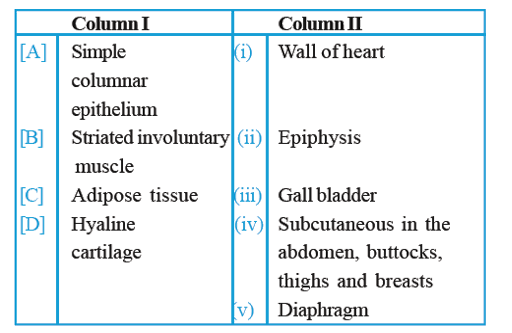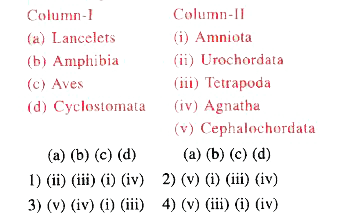Match Column -I with Column -II and select the correct option from the codes given below .
Column-IColumn-II(a)Choanocytes(i)Platyhelminthes(b)Cnidoblasts (ii)Ctenophora(c)Flame cells (iii)Porifera(d)Nepphridia(iv)Cnidaria(e)Comb plates(v)Annelida
(a)(b)(c)(d)(e)(ii)(i)(iv)(v)(iii)
(a)(b)(c)(d)(e)(ii)(iv)(i)(v)(iii)
(a)(b)(c)(d)(e)(v)(i)(iii)(ii)(iv)
(a)(b)(c)(d)(e)(iii)(iv)(i)(v)(ii)
The correct Answer is:D
To solve the matching question, we will systematically match each term from Column-I with the corresponding term from Column-II based on their biological significance.
1. Match Choanocytes:
- Choanocytes are also known as collar cells and are characteristic of the phylum Porifera (sponges).
- Match: (a) Choanocytes → (iii) Porifera
2. Match Cnidoblasts:
- Cnidoblasts, also known as cnidocytes, are specialized cells found in the phylum Cnidaria (jellyfish, corals, etc.) that contain stinging structures called nematocysts.
- Match: (b) Cnidoblasts → (iv) Cnidaria
3. Match Flame Cells:
- Flame cells are excretory structures found in the phylum Platyhelminthes (flatworms) and are involved in osmoregulation.
- Match: (c) Flame cells → (i) Platyhelminthes
4. Match Nephridia:
- Nephridia are excretory organs found in the phylum Annelida (segmented worms) and also play a role in osmoregulation.
- Match: (d) Nephridia → (v) Annelida
5. Match Comb Plates:
- Comb plates are characteristic of the phylum Ctenophora (comb jellies) and are used for locomotion.
- Match: (e) Comb plates → (ii) Ctenophora
Final Matches:
- (a) Choanocytes → (iii) Porifera
- (b) Cnidoblasts → (iv) Cnidaria
- (c) Flame cells → (i) Platyhelminthes
- (d) Nephridia → (v) Annelida
- (e) Comb plates → (ii) Ctenophora
Correct Option:
Based on the matches, the correct option is:
- A3, B4, C1, D5, E2
- Choanocytes are also known as collar cells and are characteristic of the phylum Porifera (sponges).
- Match: (a) Choanocytes → (iii) Porifera
- Cnidoblasts, also known as cnidocytes, are specialized cells found in the phylum Cnidaria (jellyfish, corals, etc.) that contain stinging structures called nematocysts.
- Match: (b) Cnidoblasts → (iv) Cnidaria
- Flame cells are excretory structures found in the phylum Platyhelminthes (flatworms) and are involved in osmoregulation.
- Match: (c) Flame cells → (i) Platyhelminthes
- Nephridia are excretory organs found in the phylum Annelida (segmented worms) and also play a role in osmoregulation.
- Match: (d) Nephridia → (v) Annelida
- Comb plates are characteristic of the phylum Ctenophora (comb jellies) and are used for locomotion.
- Match: (e) Comb plates → (ii) Ctenophora
- (a) Choanocytes → (iii) Porifera
- (b) Cnidoblasts → (iv) Cnidaria
- (c) Flame cells → (i) Platyhelminthes
- (d) Nephridia → (v) Annelida
- (e) Comb plates → (ii) Ctenophora
Based on the matches, the correct option is:
- A3, B4, C1, D5, E2
Topper's Solved these Questions
- ANIMAL KINGDOM BOOK - AAKASH SERIESCHAPTER - ANIMAL KINGDOM EXERCISE - EXERCISE -II (CHORDATA - GENERAL CHARACTERS AND OUTLINE CLASSIFICATION)
13 Videos
- ANIMAL KINGDOM BOOK - AAKASH SERIESCHAPTER - ANIMAL KINGDOM EXERCISE - EXERCISE -II (PISCES)
14 Videos
- ANIMAL KINGDOM BOOK - AAKASH SERIESCHAPTER - ANIMAL KINGDOM EXERCISE - EXERCISE -II (HEMICHORDATA)
3 Videos
- BIODIVERSITY AND CONSERVATIONBOOK - AAKASH SERIESCHAPTER - BIODIVERSITY AND CONSERVATIONEXERCISE - EXERCISE-II India - A major Source of Biodiversity and its Preservation
2 Videos
Similar Questions
Match Column I with Column II and select correct option from the codes given below.

View SolutionMatch column I with column II and select the correct option from the codes given below
Column IColumn IIA.Choanocytes(i)PlatyhelminthesB.Chindoblasts(ii)CtenophoraC.Flame cells(iii)PoriferaD.Nephridia(iv)CoelenterataE.Comb plates(v)Annelida
View Solution
Knowledge Check
Match column I with II column II and select the correct option from the given codes .
 AA-(ii), B-(iii), C-(iv), D-(i)BA-(iii), B-(ii), C-(i), D-(iv)CA-(iii), B-(ii), C-(iv), D-(i)DA-(i), B-(ii), C-(iii), D-(iv)
AA-(ii), B-(iii), C-(iv), D-(i)BA-(iii), B-(ii), C-(i), D-(iv)CA-(iii), B-(ii), C-(iv), D-(i)DA-(i), B-(ii), C-(iii), D-(iv)Match the following Columns
Column I Column IIA.Bulliform cells(i)StomataB.Guard cells(ii)Aerating poreC.Lenticel(iii)Accessory cellsD.Subsidiary cell(iv)Isobilateral leafAA-(ii), B-(i), C-(iv),D-(v),E-(iii)BA-(ii),B-(iv),C-(i),D-(v),E-(iii)CA-(v),B-(i),C-(ii),D-(ii),E-(iv)DA-(iii),B-(iv),C-(i),D-(v),E-(ii)Match column I and II and select the correct option from the given codes.
 AA-(iii),B-(iv),C-(i), D-(v), E-(ii)BA-(iii),B-(i),C-(iv), D-(v), E-(ii)CA-(iii),B-(iv),C-(v), D-(i), E-(ii)DA-(ii),B-(iv),C-(i), D-(v), E-(iii)
AA-(iii),B-(iv),C-(i), D-(v), E-(ii)BA-(iii),B-(i),C-(iv), D-(v), E-(ii)CA-(iii),B-(iv),C-(v), D-(i), E-(ii)DA-(ii),B-(iv),C-(i), D-(v), E-(iii)
Match the items given in Column - I with those in Column - II and select the correct option from the codes given below .

View SolutionMatch Column -I with Column -II select the correct option from the codes given below .
Column -I (Scientific name )Column -II (Common name )(a)Chelone (i)Turtle (b)Testudo(ii)Tortoise(c)Calotes(iii)Tree lizard(d)Chamaelon(iv)Garden lizard
View SolutionMatch column I with Column II and select the correct option from the codes given below
Column IColumn IIA. Pteris(i). BryophyteB. Cedrus(ii). PteridophyteC. Sonchus(iii). GymnospermsD. Marchantia(iv). Angiosperm
View SolutionMathc column I with column II and select the correct option from the given codes.

View SolutionMathc column I with column II and select the correct option from the given codes.

View Solution
